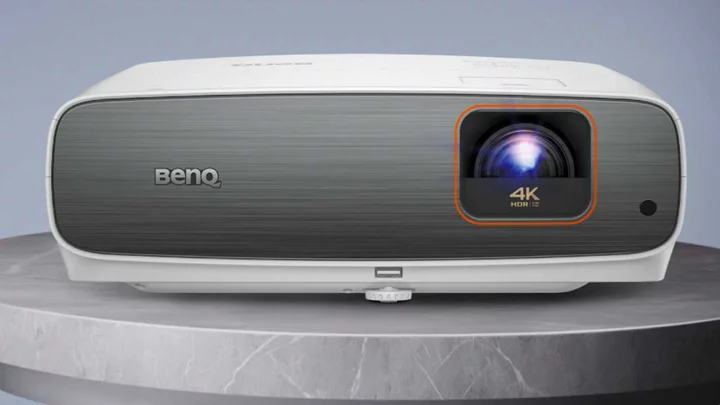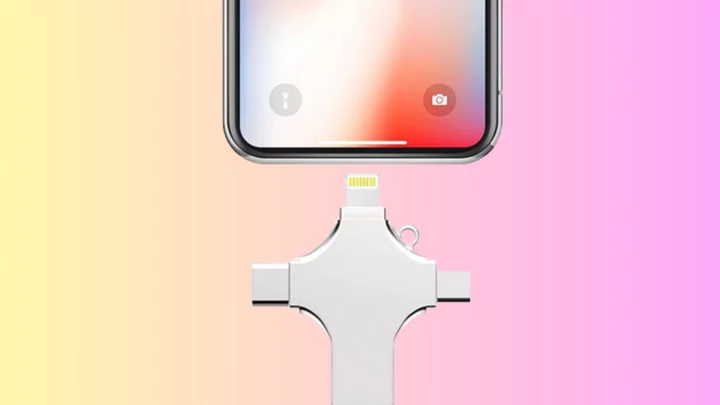The BenQ TK860i ($1,799) is the latest addition to BenQ's TK800 series of home entertainment projectors, which are designed for viewing in rooms with ambient light. Don't mistake it for a minor refresh, though. Although the model number ratchets up only a little from the TK850 that it's replacing, the image quality is a significant upgrade. BenQ's HDR-PRO technology enhances the projector's shadow detail, contrast, and sense of three-dimensionality for HDR input, and it actually enhances SDR input, too. It's enough to make the TK860i our newest Editors' Choice pick for a lamp-based 4K home entertainment projector.
Some Disassembly Required
As with most 4K projectors today, the TK860i is built around a 1,920-by-1,080-pixel DLP chip that uses TI's fast-switch pixel shifting to put 3,840 by 2,160 pixels on the screen. It pairs that with a lamp and a four-segment color wheel that uses red, green, blue, and white segments. The white panel is standard for DLP projectors meant for use in ambient light, because it helps boost brightness. The disadvantage is that it can also hurt color accuracy, and it does in this case, but not by enough for most people to consider a problem. (More on color accuracy later.)
Fairly bulky, at 5 by 15 by 10 inches (HWD) and 9.3 pounds, the TK860i is meant for permanent installation, whether on a flat surface or in a ceiling mount. Except for installing the BenQ Android TV dongle (which we'll come back to shortly), physical setup is standard, with a manual focus and manual 1.3x zoom. You'll find a generous total of three HDMI 2.0b ports on the back panel, which means you can take advantage of the one that supports ARC and eARC for an external audio system and still have two connectors free for, say, a cable box and a gaming console.
(Credit: BenQ)Another nice touch is the small vertical lens shift, which lets you adjust image position by plus or minus 5% of the image height from the center position. The feature helps avoid having to tilt the projector and then having to square off the image with a digital keystone adjustment, which would lower brightness and can introduce image artifacts.
One setup issue we've seen consistently in BenQ's smart TV projectors is that the included Android TV dongle requires a fairly involved installation process. Typically the setup involves removing screws to open a compartment with a hidden HDMI port for the dongle and a cable for supplying power to it. For most models, including the TK860i, this is a one-time minor annoyance at worst, but it's still a puzzle you need to solve if you want to use the built-in streaming features. BenQ hides the screws in small square depressions in the case—one of which is indistinguishable from myriad holes in the cooling grid that surrounds the screw. What turns setup into a puzzle is that the picture-based setup instructions give only the vaguest indication of where the screws are and make it look more like you need to pry the cover off with a screwdriver than actually unscrew anything. In addition, the holes are deep enough to allow only the thinnest of screwdrivers to fit, so once you find the screws, you may have to spend time finding an appropriate screwdriver. This makes setup harder than it should be at best, and potentially frustrating at worst. The setup experience would be much improved if BenQ installed the dongle before shipping.
Once the dongle is in place, the rest of the Android TV setup is fairly standard, with Wi-Fi as the only connection choice.
(Credit: BenQ)The onboard pair of 5-watt chamber speakers delivered enough quality and volume in our tests to be usable in a medium-to-large family room. If you want better audio, however, you can connect an external sound system to the 3.5mm or S/PDIF audio out ports, or to the one HDMI port that supports ARC and eARC.
Impressive Picture Quality for a Family Room Projector
The TK860i menus offer four predefined picture modes for SDR input, plus a user mode. As with many projectors, the brightest mode, Bright, showed an obvious green bias, making it best avoided. Most people will consider the colors more than acceptable in any of the other modes, though yellows, reds, and blues in all three tended to be a little darker in my tests than they should be. For my viewing tests, I choose Cinema mode, because it had the best color accuracy. Note that the menus offer extensive settings options you might want to adjust, including a color management system for those who want to do a full calibration. For my tests, I turned on the Local Contrast Enhancer, which improved both contrast and shadow detail.
For viewing 1080p SDR movies and video in a dark room, the TK860i delivered top-tier color saturation, contrast, and sense of three dimensionality for a projector that's bright enough to stand up to ambient light, along with color accuracy that's good enough by most people's standards. It also kept almost all of the shadow detail and dramatic visual impact that's meant to show in the most challenging dark scenes in our test suite.
(Credit: BenQ)For HDR, the TK860i supports HDR10 and HLG, with two picture modes available for each. For my tests using HDR10 input, the choices were HDR10 and HDR Game. BenQ says the projector covers 98% of the Rec.709 color gamut standard for HDTV, and is designed to optimize color mapping. In addition, it offers BenQ's HDR-PRO technology for enhanced tone mapping, which includes both the already-mentioned Local Contrast Enhancer plus a dynamic iris (and the algorithms that control it) to adjust overall image brightness based on the image content.
Both HDR-PRO features are turned on by default in all of the HDR modes, but you may want to adjust them. In my tests, the default setting for the dynamic iris tended to adjust the brightness in sudden, distracting steps when the image changed even slightly. Switching it from High to Medium eliminated most of the distraction. Once you have the settings where you want them, you can savor the picture, which delivered all the same strengths for HDR image quality as for SDR.
(Credit: BenQ)For full HD 3D, the TK860i supports DLP-Link glasses, using a single 3D mode. The image showed a slight yellow bias in my tests, and 3D-related motion artifacts were a little more obvious than is typical today, but I didn't see any crosstalk.
For gamers, the TK860i offers shorter lag times than most projectors today, though not quite state-of-the-art short. For 4K at 60Hz, I timed it with a Bodnar meter at 17.9 milliseconds (ms). For 1080p, I measured the same lag at 60Hz, a slightly longer 21.3ms at 120Hz, and just 8.8ms at 240Hz.
(Credit: BenQ)Rainbow artifacts may or may not be an issue. Although I saw them more frequently in my tests than is typical today, they were so fleeting that if you don't see them as easily as I do, you may not see them at all. Our standard advice applies: Be sure to buy the projector from a dealer that allows easy returns without a restocking fee, so you can test it out for yourself.
Using the Society of Motion Picture and Television Engineers (SMPTE) recommendations, the TK860i's rated 3,300 lumens is enough to light up a 260-inch 16:9 screen with a gain of 1.0 in a dark room. Using the lower-brightness Cinema mode, it easily filled my 90-inch 1.0-gain screen in a dark room or with lights on. In a family room with lots of windows, it was easily bright enough to watch using an 80-inch screen on a bright day.
Verdict: A Top-Tier 4K Projector
For those who don't see, or don't mind seeing, red/green/blue flashes of rainbow artifacts common with DLP projectors, the BenQ TK860i is our Editors' Choice pick for a standard-throw, lamp-based 4K home entertainment projector. If you're considering it, but you're particularly bothered by rainbow artifacts, also take a look at the Optoma UHD55, which doesn't offer as many features (only two HDMI ports, for example), but is a close competitor, delivers shorter lag times, tends to show fewer rainbows, and—at this writing at least—costs less.
Also consider the Epson Pro Cinema 4050 or its near twin, the Epson Home Cinema 4010. These two models have resolutions that aren't actually 4K, but are visually indistinguishable from 4K. The 4050's image quality makes it our top pick in its price category for viewing in a dark home theater, but it's also bright enough for use in ambient light. And because the 4050 and 4010 are three-chip LCD projectors, they're guaranteed not to show rainbow artifacts.
If you're a serious gamer, meanwhile, you might want to consider the BenQ X3000i, our current top pick for a 4K gaming projector. Along with state-of-the-art short lag times, it offers several variations on Game mode, each designed for a different type of game. Ultimately, though, if you don't see rainbow artifacts easily and you're not a hardcore gamer, the BenQ TK860i is an obvious pick.









